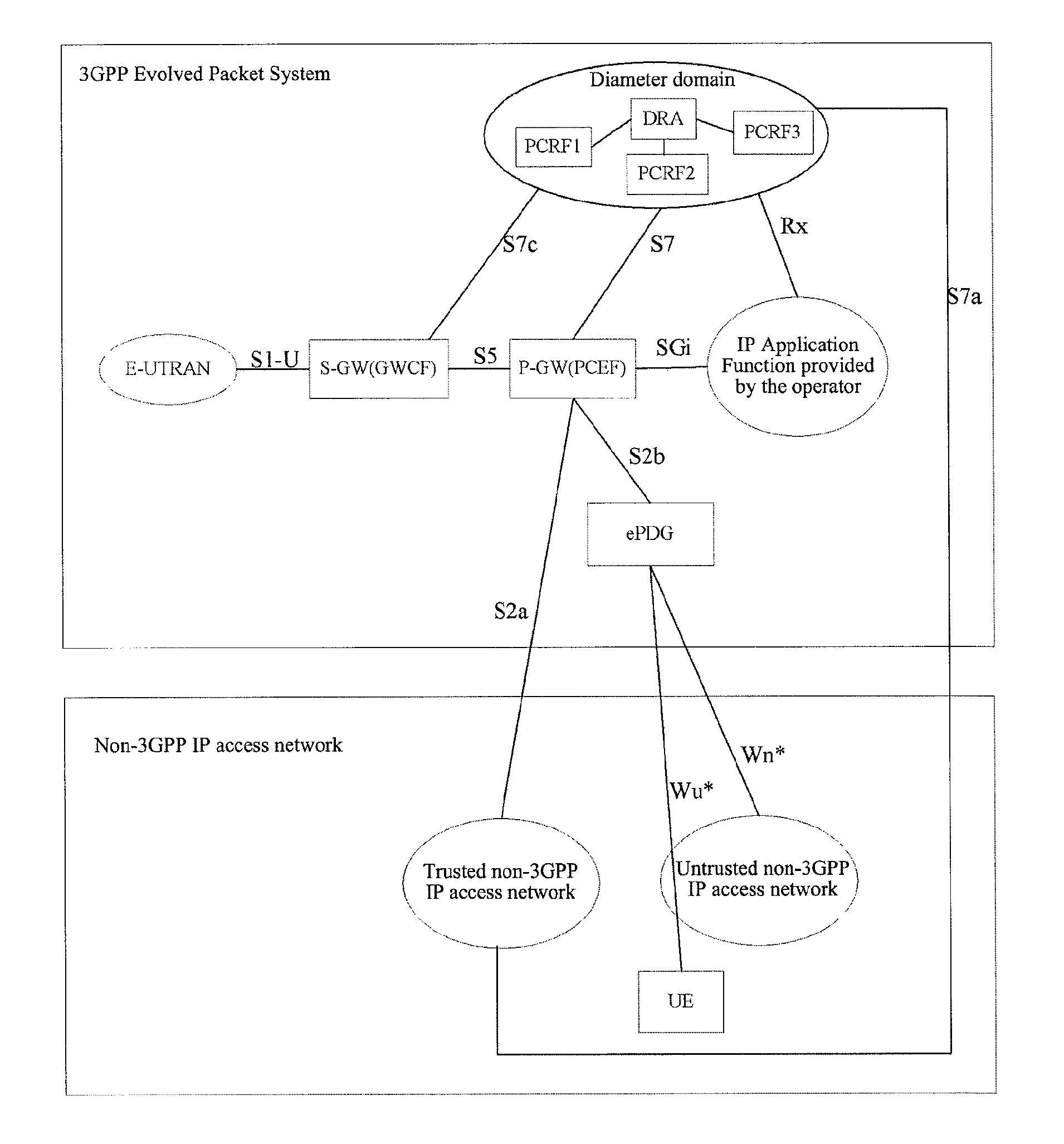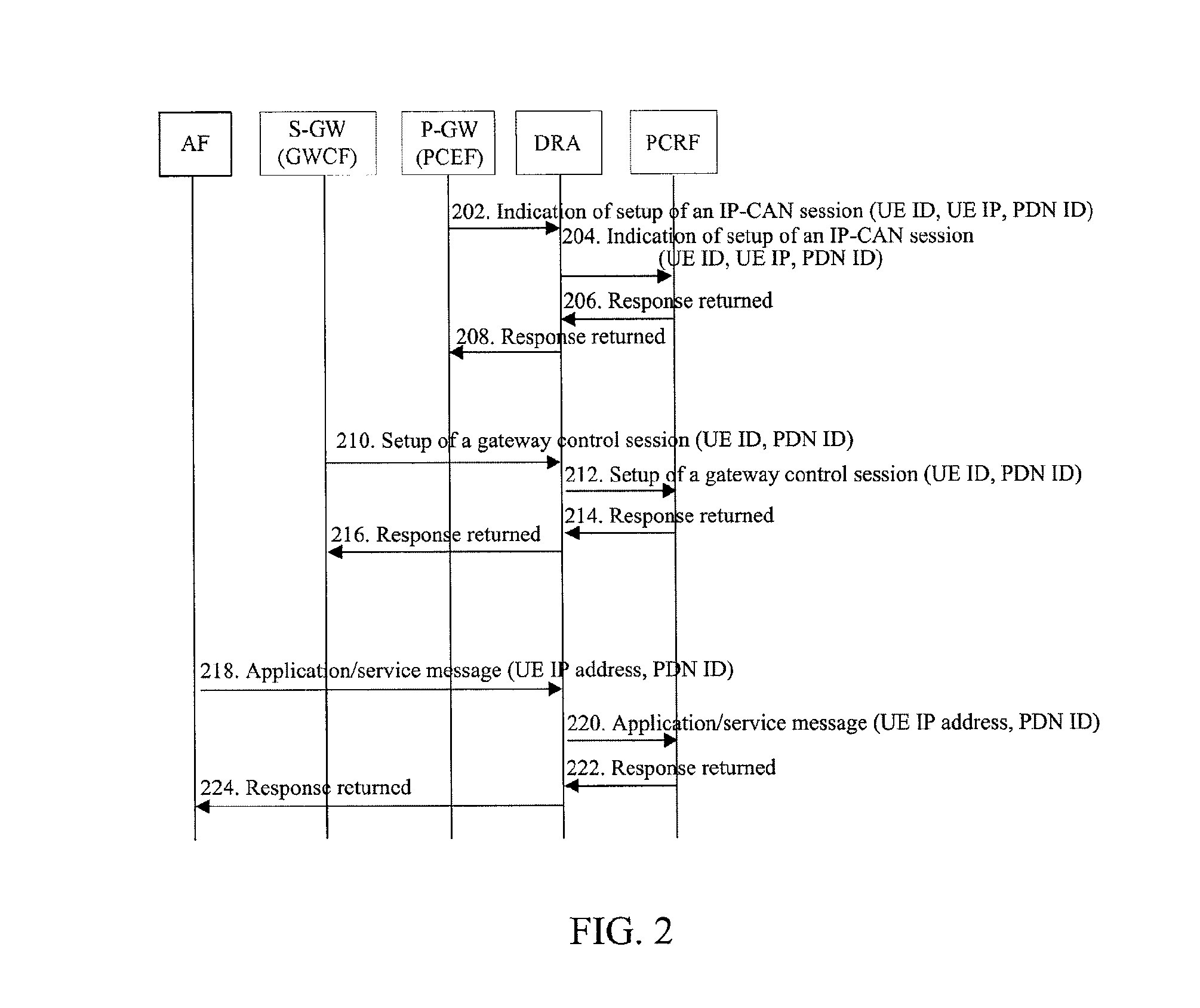Method for selecting a policy and charging rules function entity in the non-roaming scenario
- Summary
- Abstract
- Description
- Claims
- Application Information
AI Technical Summary
Benefits of technology
Problems solved by technology
Method used
Image
Examples
embodiment 1
[0040]A process, in which the protocol of an interface between an S-GW and a P-GW in the EPC is based on the PMIP, and a UE within the coverage of 3GPP initiates an IP-CAN session, is described in this embodiment. Firstly, the UE initiates an IP-CAN session setup request to the P-GW, which forwards a message to a PCRF through a DRA; after the DRA selects the PCRF and stores locally an association relation between the IP-CAN session and the PCRF, the S-GW and an AF forwards a network control session setup message and an application / service message respectively to the same PCRF through the DRA. A flow chart of this process is illustrated in FIG. 2, and each step of it is described as follows.
[0041]202: The P-GW sends a message indicating an IP-CAN session is set up to the DRA to notify the PCRF that the IP-CAN session is set up. The message contains information of UE ID, UE IP address, PDN ID and IP-CAN session ID.
[0042]Herein, the P-GW selects the DRA according to local configuration...
embodiment 2
[0055]A process, in which a trusted non-3GPP access gateway and a P-GW use the Mobile Internet Protocol (MIP) and set up a MIP tunnel between them, and a UE within the coverage of a trusted non-3GPP access network initiates an IP-CAN session, is described in this embodiment. Firstly, the UE initiates an IP-CAN session setup request, and the P-GW forwards a message to a PCRF through a DRA; the DRA selects the PCRF after receiving the message from the P-GW, and stores locally an association relation between the IP-CAN session and the PCRF; then the trusted non-3GPP access gateway and an AF forwards a network control session setup message and an application / service message respectively to the same PCRF through the DRA. The flow chart of this process is illustrated in FIG. 3, and each step of it is described as follows.
[0056]302: The P-GW sends a message indicating an IP-CAN session is set up to the DRA to notify the PCRF that the IP-CAN session is set up. The message contains informati...
embodiment 3
[0069]A process, in which a UE within the coverage of untrusted non-3GPP initiates an IP-CAN session, is described in this embodiment. Firstly, the UE initiates an IP-CAN session setup request, and a P-GW forwards a message to a PCRF through a DRA; the DRA selects the PCRF after receiving the message from the P-GW, and stores locally an association relation between the IP-CAN session and the PCRF; then an AF forwards an application / service message of the IP-CAN session to the same PCRF through the DRA. The flow chart of this process is illustrated in FIG. 4, and each step of it is described as follows.
[0070]402: The P-GW sends a message indicating an IP-CAN session is set up to the DRA to notify the PCRF that the IP-CAN session is set up. The message contains information of UE ID, UE IP address and PDN ID.
[0071]404: After the DRA receives the message, it searches for the PCRF information associated with the IP-CAN session by using the information of the UE ID, UE IP address and PDN ...
PUM
 Login to View More
Login to View More Abstract
Description
Claims
Application Information
 Login to View More
Login to View More - R&D
- Intellectual Property
- Life Sciences
- Materials
- Tech Scout
- Unparalleled Data Quality
- Higher Quality Content
- 60% Fewer Hallucinations
Browse by: Latest US Patents, China's latest patents, Technical Efficacy Thesaurus, Application Domain, Technology Topic, Popular Technical Reports.
© 2025 PatSnap. All rights reserved.Legal|Privacy policy|Modern Slavery Act Transparency Statement|Sitemap|About US| Contact US: help@patsnap.com



